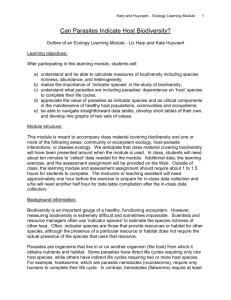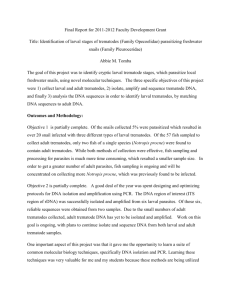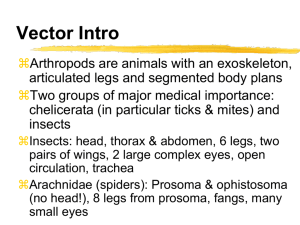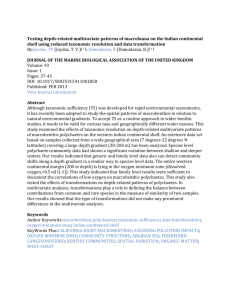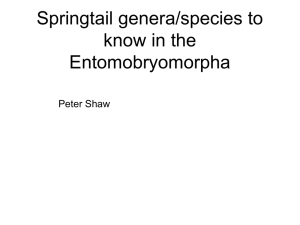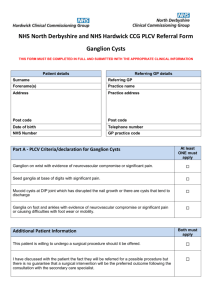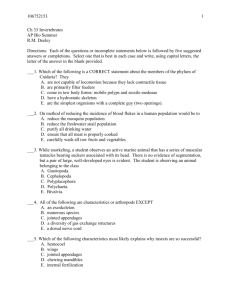First documentation and molecular confirmation of three trematode species
advertisement
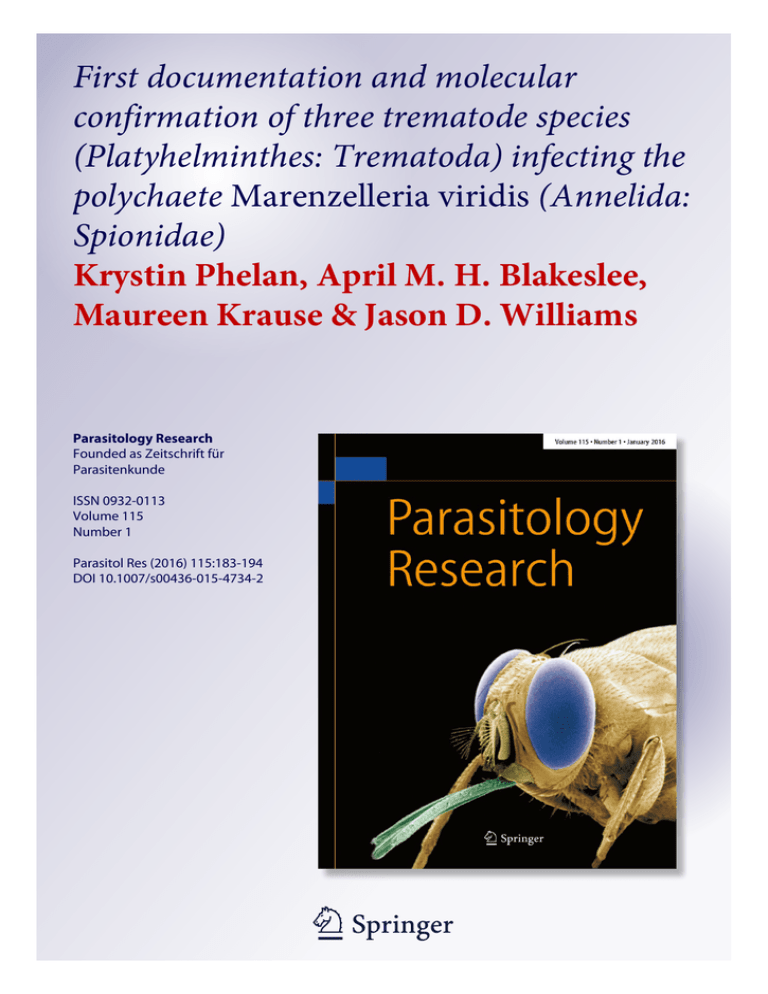
First documentation and molecular confirmation of three trematode species (Platyhelminthes: Trematoda) infecting the polychaete Marenzelleria viridis (Annelida: Spionidae) Krystin Phelan, April M. H. Blakeslee, Maureen Krause & Jason D. Williams Parasitology Research Founded as Zeitschrift für Parasitenkunde ISSN 0932-0113 Volume 115 Number 1 Parasitol Res (2016) 115:183-194 DOI 10.1007/s00436-015-4734-2 1 23 Your article is protected by copyright and all rights are held exclusively by SpringerVerlag Berlin Heidelberg. This e-offprint is for personal use only and shall not be selfarchived in electronic repositories. If you wish to self-archive your article, please use the accepted manuscript version for posting on your own website. You may further deposit the accepted manuscript version in any repository, provided it is only made publicly available 12 months after official publication or later and provided acknowledgement is given to the original source of publication and a link is inserted to the published article on Springer's website. The link must be accompanied by the following text: "The final publication is available at link.springer.com”. 1 23 Author's personal copy Parasitol Res (2016) 115:183–194 DOI 10.1007/s00436-015-4734-2 ORIGINAL PAPER First documentation and molecular confirmation of three trematode species (Platyhelminthes: Trematoda) infecting the polychaete Marenzelleria viridis (Annelida: Spionidae) Krystin Phelan 1 & April M. H. Blakeslee 2 & Maureen Krause 1 & Jason D. Williams 1 Received: 22 June 2015 / Accepted: 4 September 2015 / Published online: 18 September 2015 # Springer-Verlag Berlin Heidelberg 2015 Abstract Polychaete worms are hosts to a wide range of marine parasites; yet, studies on trematodes using these ecologically important species as intermediate hosts are lacking. During examination of the spionid polychaete Marenzelleria viridis collected on the north shore of Long Island, New York, putative trematode cysts were discovered in the body cavity of these polychaetes. In order to verify these cysts as metacercariae of trematodes, specimens of the eastern mudsnail Ilyanassa obsoleta (a very common first intermediate host of trematodes in the region) were collected for molecular comparison. DNA barcoding using cytochrome C oxidase I regions confirmed the presence of three species of trematodes (Himasthla quissetensis, Lepocreadium setiferoides, and Zoogonus lasius) in both M. viridis and I. obsoleta hosts. Brown bodies were also recovered from polychaetes, and molecular testing confirmed the presence of L. setiferoides and Z. lasius, indicating an immune response of the polychaete leading to encapsulation of the cysts. From the 125 specimens of M. viridis collected in 2014, 95 (76.8 %) were infected with trematodes; of these 95 infected polychaetes, 86 (90.5 %) contained brown bodies. This is the first confirmation that trematodes use M. viridis as a second intermediate host and that this intermediate host demonstrates a clear immune response to Electronic supplementary material The online version of this article (doi:10.1007/s00436-015-4734-2) contains supplementary material, which is available to authorized users. * Jason D. Williams biojdw@hofstra.edu 1 Department of Biology, Hofstra University, Hempstead, NY 11549-1140, USA 2 Department of Biology, East Carolina University, Greenville, NY 27858, USA metacercarial infection. Future research should explore the role of these polychaetes in trematode life cycles, the effectiveness of the immune response, and transmission pathways to vertebrate definitive hosts. Keywords Digenean . DNA barcoding . Ilyanassa obsoleta . Marine . Northwest Atlantic . Parasite Introduction Polychaete worms are ecologically important members of many benthic marine habitats that form critical links in food webs (Cosson et al. 1997; Marcogliese 2002). In addition, they can be important hosts for a range of marine parasites (Margolis 1971, 1973). Polychaetes have been documented as second intermediate hosts in the life cycles of a variety of trematode species (Peoples 2013); however, compared to the rich literature on other host groups, research on trematode/ polychaete interactions and host specificity is lacking (but see Peoples and Poulin 2011; Peoples et al. 2012). Trematodes infect polychaete worms after being released from their first intermediate hosts (typically gastropod molluscs). Within gastropod hosts, trematodes replace host tissue (especially in the gonad region, resulting in castration) and may occupy a significant portion of the shell volume (Leung et al. 2009a). After developing as sporocysts and/or rediae and multiplying asexually, they emerge from the first intermediate host as free-swimming cercariae and seek a second intermediate host, which may be polychaetes or other invertebrate or vertebrate taxa. Within second intermediate hosts, they encyst as metacercariae until they are ingested by a definitive host (some trematodes lack a second intermediate host and form metacercarial cysts on substrates, or emerging cercariae can directly penetrate definitive hosts). Once in the Author's personal copy 184 definitive host, trematodes complete their life cycle by reproducing sexually and releasing eggs through the host’s feces (Cribb 2005). Trematodes typically do not kill their hosts but can affect their behavior, overall fitness, and, scaled up to the community level, the structure of coastal systems (e.g., Mouritsen and Poulin 2005; Wood et al. 2007; Kuris et al. 2008). Although some trematodes exhibit an abbreviated life cycle and reach sexual maturity within a single molluscan host (Poulin and Cribb 2002), most have a complex life cycle consisting of at least two hosts. They parasitize a diverse range of invertebrates (arthropods, molluscs, and annelids) and vertebrates across many ecosystems (Smith et al. 2007). A variety of vertebrates (e.g., fish, birds, and mammals) serve as definitive hosts for trematode species. Although trematodes exhibit an amazing diversity of life cycles, one nearly consistent characteristic of them all is the use of molluscs as a first intermediate host (Esch et al. 2002). Polychaete worms represent the only other non-molluscan group documented to act as a first intermediate host to trematodes (see Køie 1982 and references therein). The trematode family Sanguinicolidae is the only digenean family known to infect non-molluscan first intermediate hosts such as marine polychaetes (Cribb et al. 2001). Within the Polychaeta, 18 families are known to act as second intermediate hosts for trematodes (Peoples 2013); however, limited sampling of polychaetes for trematode infection suggests that there may be many undocumented potential hosts (Peoples et al. 2012). Within the family Spionidae, only five species, Polydora ciliata (Johnston, 1838), Polydora cornuta (=ligni) Bosc, 1802, Pygospio elegans Claparède, 1863, Spio sp., and Streblospio benedicti Webster, 1879 (McCurdy et al. 2000; Peoples 2013), have been shown to host trematodes. All of these species are host to the trematode Lepocreadium setiferoides (Miller & Northup, 1926), which is native to the North Atlantic and uses the eastern mudsnail Ilyanassa obsoleta (Say, 1822) as its first host and fish such as the flounder Pseudopleuronectes americanus (Walbaum, 1792) as its definitive host (Stunkard 1972). At least nine other polychaetes along the east coast of the USA are second intermediate hosts for trematodes after release of cercariae from I. obsoleta (Curtis 1997, 2009; Blakeslee et al., 2012) (Table 1). The present work reports on new records of trematodes in the spionid polychaete Marenzelleria viridis (Verrill, 1873) collected on the north shore of Long Island, New York. The species of focus, M. viridis, is an infaunal polychaete that burrows in sandy substrates of brackish to estuarine waters along the east coast of North America from Nova Scotia to Georgia but has also been introduced to the Baltic Sea, North Sea, and Danish Waters (e.g., Maciolek 1984; Zettler 1997a, 1997b; Zander and Reimer 2002; Sikorski and Bick 2004; Blank et al. 2008; Delefosse et al. 2012). M. viridis is a deposit-feeding polychaete (Miller et al. 1992) that can reach high densities and have important ecological impacts, Parasitol Res (2016) 115:183–194 particularly in reducing other infaunal macroinvertebrates, possibly through competition for food and space (Delefosse et al. 2012). M. viridis also contributes greatly to the ecology of benthic communities by accelerating nitrogen remineralization, biodeposition processes, bioturbation, and ventilation in the sediment (Kotta et al. 2001; Quintana et al. 2011; Renz and Forster 2013; Jovanovic et al. 2014). While studying M. viridis on the coast of Long Island, New York, preliminary investigations discovered clear to light green cysts resembling those of trematodes inside the polychaetes. Also observed were brown, opaque cyst-like structures. We hypothesized that these structures could represent an immune response of the annelids caused by the encapsulation of foreign objects too large to be phagocytized (Sima 1994). Although best studied in oligochaetes, cellular immunity has also been found in several polychaetes that are known to encapsulate living and non-living material (Cuvillier-Hot et al. 2014). This encapsulation forms a granuloma, producing Bbrown bodies^ or Bgranulomata^ (Dales 1983; PorchetHenneré et al. 1987, 1990; Porchet-Henneré and M’Berri 1987; Porchet-Henneré and Vernet 1992; Valembois et al. 1992, 1994; Beschin et al. 1999; Dhainaut and Scaps 2001; Reinhart and Dollahon 2003; Field et al. 2004; Procházková et al. 2006; Cuvillier-Hot et al. 2014). While metacercariae have been documented in a wide range of polychaetes, encapsulation and brown body formation have not been studied in detail and few records exist from polychaetes collected in the field (Shaw 1933). Polychaetes, particularly tube-dwelling species, are often infected by trematodes in anterior segments, most likely due to the branchial currents bringing cercariae into contact with this region first (Shaw 1933; Stunkard 1938; Brown and Prezant 1986; Rangel and Santos 2009; Peoples and Poulin 2011). The purpose of this research was to investigate the cysts and brown bodies found in M. viridis. Specifically, we used DNA barcoding (as previously completed for flatworms: Vilas et al. 2005; Leung et al. 2009a, 2009b; Moszczynska et al. 2009; Sanna et al. 2009) and light microscopy to determine which species of trematode metacercariae were present in the polychaetes. We suspected that the first intermediate host for the trematodes infecting M. viridis could be the abundant eastern mudsnail (I. obsoleta), a common host to several trematode species in the region. Thus, DNA barcoding was also performed on trematode species identified in the snail and then compared to the DNA from the polychaetes. Finally, the prevalence and distribution of metacercarial cysts and brown bodies within specimens of M. viridis were quantified. Altogether, our work describing this previously undocumented host-parasite relationship can help inform future ecological studies in the region, as well as potential impacts on the bird and fish predators that act as definitive hosts for the trematodes. (Martin, 1945) (Linton, 1905) Diplostomum nassa Gynaecotyla adunca (Miller & Northup, 1926) Hunter, 1961 (Linton, 1900) Lepocreadium setiferoides Pleurogonius malaclemys Stephanostomum dentatum Himasthla quissetensis (Miller & Northup, 1926) (Miller & Northup, 1926) Austrobilharzia variglandis Fundulus heteroclitus, Mugil cephalus Americorchestia longicornis, Americorchestia megalophthalma, Uca pugilator, Corophium volutator None; cercaria penetrate definitive host directly Second intermediate host(s)a Acanthocolpidae Menidia menidia Echinostomatidae Argopecten irradians, Cerastoderma edule, Crepidula fornicata, Cumingia tellinoides, Ensis directus, Geukensia demissa, Modiolus modiolus, Mya arenaria, Mytilus edulis, Leitoscoloplos fragilis Lepocreadiidae Chaetozone setosa, Childia groenlandica, Chrysaora quinquecirrha, Eteone longa, Euplana gracilis, Foviella warreni, Heteromastus filiformis, Polydora ciliata, Polydora cornuta, Pygospio elegans, Scoloplos armiger, Streblospio benedicti, Stylochus ellipticus Pronocephalidae None, encysts on vegetation and other surfaces Microphallidae Diplostomatidae Schistosomatidae Taxonomic authority Family Trematode species Paralichthys dentatus, Sphoeroides maculatus Chelonia mydas, Malaclemys terrapin Hippoglossoides platessoides, Pleuronectes putnami, Myoxocephalus octodecemspinosus, Pseudopleuronectes americanus Redia Redia Redia Sporocysts Larus argentatus, Larus atricilla, Ammospiza maritime maritima, Charadrius wilsoni, Rallus longirostris, Calidris alba, Opsanus tau, Sphoeroides maculatus, Balistes capriscus, Procyon lotor, Rhynchops nigra, Sternula albifrons, Sterna hirundo Redia Larus argentatus, Larus atricilla, Larus marinus, Nycticorax nycticorax, Rallus longirostris, Sterna hirundo Curtis 2009 Curtis 2009 Blakeslee et al. 2012 Ehrhardt et al. 1966; Barber and Caira 1995 References for host data Monostomate cercaria (unforked tail with setae, only oral sucker present, eyes present) Parapleurolophocercous cercaria (unforked tail with lateral finfolds, eyes present) Blakeslee et al. 2012 Hunter 1967 Oculate trichocercous cercaria Curtis 2009 (unforked tail with setae, eyes present) Echinostome cercaria (unforked tail, anterior end with spiny collar) Strigea cercaria (forked tailed, eyes absent) Xiphidiocercaria (unforked tail, stylet in oral sucker) Brevifurcate-apharyngeate cercaria (forked tailed, eyes present) Larval type in snails Cercarial morphological typeb (key features used to identify) Sporocysts Anas rubripes, Arenaria interpres, Aythya affinis, Branta canadensis, Larus argentatus, Larus atricilla, Larus delawarensis, Larus marinus, Melanitta deglandi, Mergus serrator, Nycticorax nycticorax, Phalacrocorax auritus Bird species Sporocysts Definitive host(s) Table 1 Nine trematode species that use Ilyanassa obsoleta as a first intermediate host. Their second intermediate hosts, definitive hosts, larval types, and cercarial morphology are provided. All hosts known (including experimental) from the northwestern Atlantic are listed Author's personal copy Parasitol Res (2016) 115:183–194 185 From McDermott 1951; Schell 1970; Yamaguti 1975; Stunkard 1970, 1983 Many of these represent experimental infections Zoogonidae Sporocysts Cercariaeum cercaria (tail absent, eyes absent) Bray 1987; Shaw 1933 Curtis 2009 Redia Oculate gymnocephalous cercaria (unforked tail, eyes present) References for host data Larval type in snails Cercarial morphological typeb (key features used to identify) Many previous authors considered this species a synonym of Zoogonus rubellus (Olsson, 1868), but as shown by Bray and Gibson (1986) and Bray (1987); these are distinct species. Zoogonus rubellus is found in the northeastern Atlantic, the Mediterranean Sea, the Red Sea, and the west coast of Africa, whereas Z. lasius is restricted to the northwestern Atlantic d Martin (1939) indicated that this species had cercaria with a stylet and reported the metacercaria of the trematode from the Atlantic silverside Menidia menidia and the American eel Anguilla rostrata; the species has a wide range of fish definitive hosts including the striped bass Roccus saxatilis. Later, McDermott (1951) found differences between the sizes and morphology of his specimens and those from New England, including lack of a stylet and setae in the cercaria. As indicated by McDermott (1951), the stylet may be missing in those naturally emerging from snails or perhaps overlooked. Positive PCR amplification of Long Island samples dissected from I. obsoleta in the present study also suggests the presence of S. tenue; the stylet and setae appeared to be absent in these samples. These findings indicate that there may be two species under the name S. tenue, and future researchers should investigate this possibility with molecular data, including material from the type locality of S. tenue (Woods Hole, MA) and compare it with material from New York and New Jersey. The species has also been reported from the Pacific Coast of Mexico, and this record should be reexamined (Bravo 1956) c b a (Leidy, 1891) Zoogonus lasiusd Definitive host(s) Ammodytes americanus, Hemitripterus americanus, Menticirrhus saxatilis, Morone saxatilis, Opsanus tau, Sphoeroides maculatus Anguilla rostrata, Liopsetta Alitta virens, Arabella iricolor, putnami, Leiostomus Arbacia punctulatus, Bdelloura xanthurus, Trinectes candida, Hydroides sp., Leonereis maculatus, Menidia culveri, Lumbrineris hebes, menidia, Paralichthys Scoloplos robusta, dentatus, Opsanus Testudinalia testudinalis tau, Tautoga onitis Anguilla rostrata, Fundulus heteroclitus, Menidia menidia (Linton, 1898) Stephanostomum tenuec Acanthocolpidae Second intermediate host(s)a Taxonomic authority Family Trematode species Table 1 (continued) Author's personal copy 186 Parasitol Res (2016) 115:183–194 Author's personal copy Parasitol Res (2016) 115:183–194 Materials and methods Sample collection and storage M. viridis polychaetes and I. obsoleta mudsnails were collected from Hempstead Harbor located in Sea Cliff, New York (40° 50′ 27.33″ N, 73° 39′ 11.65″ W) from May 2013 to July 2014. Polychaetes (n=33 in 2013, n=125 in 2014) were collected with a shovel and sieve (0.5 mm mesh size) and placed in buckets containing unfiltered seawater. The 2013 collection of polychaetes was non-random; we specifically isolated polychaetes that appeared to contain cysts in order to document the presence of trematodes and refine amplification and sequencing protocols necessary for that work. The 2014 polychaetes were collected randomly to assess prevalence and incidence of trematode infection. Mudsnails (n= 274 in 2013; n=100 in 2014) were collected haphazardly by hand at the same locality. After transport to the lab, mudsnails were stored in a refrigerator at ~14 °C with aeration until time of dissection and analysis. Specimens of M. viridis were dissected within 24 h of collection. Sample dissection Shells of live I. obsoleta were cracked, and confirmation of trematodes was made by the presence of cercariae and sporocysts and/or rediae in the tissue dissected from the digestive and/or reproductive glands using a compound light microscope. Larval trematodes were identified based on McDermott (1951) (see Table 1 herein). Samples of the parasites were stored in 70 % ethanol for later molecular work. In order to immobilize M. viridis for dissection, the polychaetes were submerged in 3 % MgCl2 (~50:50 mixture of 7 % MgCl2 and seawater) and placed in the freezer for approximately 20 min. Specimens of M. viridis often had sand and organic particles in the posterior end of their digestive tract, making it difficult to observe/confirm cysts in this region; for this reason, only the anterior segments (~30–60 segments) were analyzed. After cutting off the posterior end, the anterior end of the polychaete was squashed between two microscope slides and observed under an Olympus SZX12 stereomicroscope and Olympus CX31 compound microscope. The total number of segments of these anterior ends, their length (in mm), and total number of cysts and brown bodies found throughout the region were quantified. The first (anteriormost) segment containing cysts or brown bodies was recorded; when polychaetes had cysts or brown bodies in >1 segment, the last (posterior-most) segment infected was also recorded. When small ovoid clear or brown cysts were observed during analysis, the individual cyst or a small section of the polychaete was cut out with a micro-scalpel and preserved in 70 % ethanol for molecular testing. In order to provide enough 187 template material for molecular studies, in some instances, more than one cyst and/or brown body per polychaete were preserved and analyzed together. During the observation of polychaete samples, the presence of both clear to light green cysts and brown opaque cysts, or brown bodies, were recorded. Pictures of each type of cyst were taken with an Olympus CX31 with Olympus DP11 camera; ImageJ was used to make length and width measurements from these images. Molecular analyses In order to excise the parasite tissue from polychaete samples, mechanical homogenization was required before DNA extraction. Fifty microliters of 5–10 % Chelex®-100 (Bio-Rad) slurry and approximately 40–50 mg of 0.5-mm BioSpec glass beads were added to the samples. Samples were vortexed for approximately 10 min. Afterwards, a simple Chelex® extraction protocol was followed (Walsh et al. 1991). Because DNA extracted by Chelex did not always result in PCR amplicons in preliminary samples, a MOBIO Laboratories, Inc. Ultraclean™ PCR Clean-up™ Kit was used before performing PCR in an attempt to remove additional PCR inhibitors following the manufacturer’s protocol. Approximately 50 μL of Chelex-purified sample was processed. A final volume of approximately 50 μL was obtained using the elution buffer (10 mM Tris). To determine which trematode species were present in the collected samples, multiple primers amplifying either the 18S or cytochrome c oxidase I (COI) barcoding regions were used (Supplemental Table 1). All primers were ordered from Invitrogen. B18S1^ and B18S2^ are universal 18S primers designed for metazoan species (Machida and Knowlton 2012). The BHq_COIF^/BHq_COIR,^ BLs_COIF^/ BLsCOIR,^ and BZl_F^/BZl_R^ primers are forward and reverse primers specific to the cytochrome C oxidase I region in the trematode species Himasthla quissetensis (Hq), L. setiferoides (Ls), and Zoogonus lasius (Zl; note that previous records of this species from the east coast of the USA as Zoogonus rubellus are actually Z. lasius; see Table 1), respectively (Blakeslee and Fowler 2012). Each PCR reaction consisted of a total volume of 30 μL and contained a final concentration of 100 μM of both forward and reverse primers along with 1× OneTaq Master Mix (New England Biolabs) containing 0.2 mM dNTPs, 20 mM Tris HCl, 22 mM KCl, 22 mM NH4HCl, and 1.8 mM MgCl2, approximately 300 ng of template DNA. Using the 18S1/ 18S2 and Hq_COIF/Hq_COIR primers, the degenerate 18S and H. quissetensis cytochrome oxidase fragments were amplified using a program which consisted of denaturing at 95 °C for 1 min, followed by 45 cycles of denaturing at 94 °C for 20 s, annealing at 50 °C for 20 s, and extending at 68 °C for 2 min with a final extension at 68 °C for 10 min. The Ls_COIF/Ls_COIR and Zl_F/Zl_R primers were used to Author's personal copy 188 amplify the L. setiferoides cytochrome oxidase fragment using a program which consisted of 96 °C for 1 min, followed by 45 cycles of 94 °C for 20 s, 52 °C for 30 s, 72 °C for 1 min, and a final DNA extension at 72 °C for 10 min. For select samples that did not amplify with any COIspecific primers and amplified mostly or all host DNA using the 18S1/18S2 primers, the Bworm A^ and Bworm B^ 18S primers were used. These primers flank variable domains 1–6 of the 18S ribosomal DNA (Machida and Knowlton 2012), a smaller region than the entire small subunit amplified by the 18S1/18S2 primer pair. They were amplified under the same conditions as the Hq_COIF/Hq_COIR and 18S/18S2 primers. If host DNA was detected in the 18S sequences using the worm A and worm B primers, this primer set served as a shorter sequencing alternative to try to obtain parasiticspecific DNA. Samples were sent out for Sanger sequencing to Macrogen Corporation (Rockville, MD, USA). In order to compare sequences, a contiguous sequence of the forward and reverse amplified DNA for each sample was made using BioEdit’s CAP contig assembly program using a minimum base overlap of 20 bases and an 85 % match minimum. The ClustalW multiple nucleotide sequence alignment tool was used to align these sequences (Li 2003). Both the distance-based neighborjoining and character-based maximum likelihood analysis algorithms were used for phylogenetic estimation (Hall 2011). Sequences of H. quissetensis, L. setiferoides, and Z. lasius were used as in-groups for these estimations while a reference sequence for the liver fluke Fasciola hepatica (Linnaeus, 1758) was used as an out-group. For each analysis, the best evolutionary model was chosen in MEGA after the data was grouped by gene, either 18S or COI. The genetic pairwise distance, using the simultaneous estimation method in MEGA 6, within each species was calculated (Tamura et al. 2004). A bootstrap method of 2000 replicates with the maximum composite likelihood methods were used for these calculations (Efron 1982). COI sequences for three specimens of H. quissetensis (two samples from I. obsoleta and one sample from M. viridis), L. setiferoides (one sample from I. obsoleta), and Z. lasius (four samples from M. viridis), as well as 18S sequences for H. quissetensis previously analyzed by Blakeslee (unpub.) from infected I. obsoleta, were used for comparison with our cyst samples from the polychaetes. Consensus COI and 18S sequences for the trematode species are shown in Supplemental Figs. 1 and 2, respectively. Results M. viridis dissected during this study were found with encysted metacercariae (Fig. 1a, b) and/or brown bodies (Fig. 1c, d) that contained trematode DNA. Though difficult to distinguish based on light microscopy unless cysts are Parasitol Res (2016) 115:183–194 removed from hosts, the metacercariae of each species have characteristic traits that distinguish them. Metacercariae of H. quissetensis have a collar of small spines surrounding the anterior end (Fig. 1e), whereas Z. lasius metacercariae have a single stylet positioned in the center of the oral sucker (Fig. 1f). Free-swimming trematode cercariae released from the first intermediate host also have species-specific traits (Table 1). The cercariae of H. quissetensis are released from sporocysts and lack eyespots and have an unforked tail and a spinous cuticle. The cercariae of L. setiferoides are released from rediae and have eyespots and a setose tail. The cercariae of Z. lasius are released from sporocysts and lack eyespots and a tail. Among the 33 polychaete samples found with cysts in 2013, 17 contained clear cysts, nine contained isolated brown body cysts, and seven contained a mixture of both clear and brown cysts. Fourteen of these samples were successfully sequenced: One was confirmed to contain only H. quissetensis, 11 contained only Z. lasius, and two samples contained both H. quissetensis and Z. lasius. No polychaete samples collected in 2013 tested positive for L. setiferoides. The remaining 19 samples did not amplify with any available primers, which may be because of DNA degradation, too little template material, or because the cysts represent other trematode species we did not have primers for. Of the 14 samples that amplified, four were from isolated brown body cysts, confirming that they contain trematode parasite DNA. In 2013, 274 mudsnails were analyzed and 13 (4.7 %) were parasitized by trematodes. Based on light microscopy examination of the cercariae, these were provisionally identified as Diplostomum nassa (one specimen), H. quissetensis (three specimens), L. setiferoides (two specimens), Stephanostomum tenue (five specimens), and Z. lasius (two specimens). In subsequent molecular analyses, four of these samples were omitted because they were sequenced before the universal 18S1/18S2 primers for H. quissetensis, L. setiferoides, and Z. lasius were available. Of the nine samples with positive PCR amplification, four were confirmed (three as H. quissetensis and one as L. setiferoides), four (one L. setiferoides and three Z. lasius) did not match the morphological identification, suggesting the possibility of co-infection, and one sample did not amplify. In 2014, 95 (76.8 %) of the 125 M. viridis dissected were found to be parasitized based on light microscopy. Of the 95 infected polychaetes, 35 (36.8 %) contained cysts and brown bodies, whereas 10 (10.5 %) contained cysts only and 50 (52.6 %) contained brown bodies only. The cysts and brown bodies overlapped in distribution within the polychaetes: they were found from segments 1 to 50 and 2 to 53, respectively (Table 2). There was no significant difference in the first and last segments of the cysts and brown bodies within M. viridis (first segment t130 =0.94, P=0.35; last segment t82 =1.23, P= 0.22). There were significantly more brown bodies than clear cysts identified within specimens of M. viridis across all our Author's personal copy Parasitol Res (2016) 115:183–194 189 Fig. 1 Trematode metacercarial cysts and brown bodies from Marenzellaria viridis. a Clear ovoid metacercarial cyst, indicated by arrowhead. b Metacercarial cyst. c Brown body found within polychaete. d Brown body dissected from body of polychaete; arrowhead shows metacercarial cyst. e Metacercarial cyst of Himasthla quissetensis (confirmed with molecular data). Arrowheads show characteristic spines in metacercaria of this species. f Metacercarial cyst containing Zoogonus lasius (confirmed with molecular data). Arrowhead shows the characteristic stylet in metacercaria of this species. Scale bars=0.1 mm samples (t106 =−9.1, P<0.001). On average, cysts (n=47) were 0.16±0.06 mm long and 0.18±0.06 mm wide whereas brown bodies (n=54) were 0.12±0.03 mm long and 0.14± 0.11 mm wide. The cysts were significantly larger than brown bodies in both length (t68 =4.31, P <0.001) and width (t82 =2.25, P=0.027). Table 2 The average length and number of segments of the anterior ends of Marenzellaria viridis dissected and examined for trematode metacercaria. Number of cysts and brown bodies in each worm and the range of segments they were found in are reported. Mean ± standard deviations are presented; sample size is 125 for all measures Cyst presence Brown body presence No. of segments Length No. of cysts First seg mean Last seg mean No. of cysts First seg mean Last seg mean 44.73±6.77 15.39±2.66 0.5±0.75 20.18±12.87 31.36±13.30 2.72±3.04 17.97±12.81 34.99±9.32 Author's personal copy 190 Of the 77 cysts and/or brown body samples tested with PCR, 46 samples had positive primer species-specific results, 35 with Z. lasius COI-specific primers, and 6 with the L. setiferoides COI-specific primers. Five samples positively amplified with both sets of primers. There were no positive identifications of H. quissetensis DNA in these samples. Although we did not have positive amplification in polychaetes, H. quissetensis was present snails (see below). Overall, nine (9 %) of the gastropod samples from 2014 were infected with trematodes. Based on light microscopy examination of the cercariae, these were provisionally identified as H. quissetensis (one specimen), L. setiferoides (three specimens), S. tenue (one specimen), Z. lasius (two specimens), and unidentified (two specimens). Molecular data confirmed four of these as trematodes (two H. quissetensis and two Z. lasius) and confirmed one of the unidentified trematodes as Z. lasius. Positive PCR amplicons suggested the possibility of co-infection in two samples and did not support the morphological identification of one of the L. setiferoides samples. One sample did not amplify. Phylogenetic trees were constructed using both the neighbor-joining and maximum likelihood methods with the COI and 18S sequences (Fig. 2). COI data produced monophyletic groupings of H. quissetensis and Z. lasius, whereas three samples of L. setiferoides were monophyletic and a fourth sample came out as basal to all in-group taxa (Fig. 2a, b). In the 18S analysis, a monophyletic grouping of H. quissetensis was also found. However, L. setiferoides grouped with Z. lasius, likely due to the fact that there was no L. setiferoides 18S sequence for reference (Fig. 2c, d). Discussion This study provides the first confirmation of the polychaete M. viridis acting as a second intermediate host for any trematode species. A high prevalence of metacercarial cysts was found in M. viridis (~77 % of polychaetes in 2014), similar to a study by McCurdy et al. (2000), which found high prevalence of trematodes in the spionids P. elegans (75 %) and S. benedicti (50 %). In total, molecular data confirmed three species of trematodes (H. quissetensis, L. setiferoides, and Z. lasius) from metacercariae in the polychaetes, all of which utilize I. obsoleta as their first intermediate host. Thus, it appears as if exposure to infected I. obsoleta from the same, or a nearby site, can result in high levels of infection in specimens of M. viridis. Even so, it remains unclear whether these trematodes would then be trophically transmitted from the polychaetes to suitable definitive hosts. For example, one of the trematode species (H. quissetensis) found infecting M. viridis use birds (seagulls and others) as definitive hosts (Table 1), but these types of birds have not been documented to feed on M. viridis. However, these birds do feed on infaunal Parasitol Res (2016) 115:183–194 invertebrates, like other species of polychaetes (Ambrose 1986; Heard 1982; Leopold and van Damme 2003), so it remains possible that trophic transmission could be occurring for this trematode species. In contrast, both L. setiferoides and Z. lasius use fish as their definitive hosts (Table 1), and both have also been documented to infect other polychaete species. M. viridis has been found in the guts of fish (Essink and Kleef 1991; Winkler and Debus 1996; Derrick and Kennedy 1997; Sardá et al. 1998) and thus may be an appropriate intermediate host for these trematodes. Detailed examination of these potential definitive hosts is required to determine whether trophic transmission is successfully occurring or if M. viridis instead represents a sink for these trematode species, acting as a low competency host or part of a Bdilution effect^ preventing transmission (Johnson and Thieltges 2010; Koppel et al. 2011). Another noteworthy result of our work is that we determined the brown bodies detected in M. viridis contain trematode DNA, confirming that they are encapsulated cysts. Thus, ours is the first study to reveal an immune response in this polychaete as a result of trematode infection. However, the time course of encapsulation and viability of brown bodies remain unknown and should be tested in the future. In prior work, several polychaetes (Hydroides sp., Lumbrineris hebes, Scoloplos robusta, and Arabella iricolor) have been shown to encapsulate the metacercaria of Z. lasius, which appeared to be dead within the capsule; alternatively, in another polychaete (Alitta virens), the metacercaria remained viable in the parapodia for over 3 weeks (Shaw 1933). Moreover, Køie (2000) noted encapsulation of a nematode parasite (Cucullanus heterochrous) during experimental infections of Hediste diversicolor and other polychaetes and showed that the nematode larvae were uninfective to fish definitive hosts after 3 weeks. Encapsulation of nematodes has also been found in oligochaete hosts, which similarly appeared to be non-infective (Poinar and Hess 1977), and in some cases was eliminated by autonomy from the oligochaete (Bilej 1994). We also found the distribution of live cysts and brown bodies to overlap within the anterior segments of the polychaetes. The prominence of cysts in the anterior region is probably the result of cercariae being drawn in by water currents created by the branchiae of M. viridis (Quintana et al., 2011). Such findings are similar to Rangel and Santos (2009) who showed the metacercariae of Gymnophallus choledochus almost exclusively in the branchial segments of Diopatra neapolitana and suggested that the cercariae may penetrate the branchiae directly. Peoples (2013) indicated that trematode cercariae may have evolved to penetrate the anterior region of polychaetes because they are more likely ingested by predators, thus increasing the likelihood for trophic transmission. In M. viridis, future studies should examine cercarial penetration of polychaete hosts, focusing on the factors that may influence their distributions within the polychaete. Author's personal copy Parasitol Res (2016) 115:183–194 191 52 Z. lasius Blakeslee 33 p22 Z. lasius A 80 p13 Z. lasius 86 p20 Z. lasius C 4C Z.lasius 73 2C Z.lasius p12 Z. lasius 8 L. setiferoides Blakeslee 1C 1C 52 33 44 84 8C H. quissetensis Blakeslee 54 6C H. quissetensis 72 82 5C H.quissetensis 5C H. quissetensis 66 43 8C 6C H.quissetensis H.quissetensis Blakeslee II pHq H. quissetensis H.quissetensis Blakeslee 29 H. quissetensis Blakeslee II L. setiferoides Blakeslee II Fasciola hepatica Fasciola hepatica 0.2 0.2 5C H. quissetensis 65 98 B 95 pHq H. quissetensis H. quissetensis Blakeslee II 6C H. quissetensis D H. quissetensis Blakeslee 74 p13 Z. lasius Z. lasius Blakeslee 99 40 90 6C H.quissetensis p12 Z. lasius 95 5C H.quissetensis 67 p20 Z. lasius 31 H.quissetensis Blakeslee p22 Z. lasius H.quissetensis Blakeslee II L. setiferoides Blakeslee 78 1C 1C 4C Z.lasius 99 8C 2C Z.lasius L. setiferoides Blakeslee II 8C Fasciola hepatica 0.2 Fasciola hepatica 0.5 Fig. 2 Phylogenetic trees of trematodes based on the COI region and 18S rRNA. a Phylogenetic tree based on the COI region using the neighborjoining method in MEGA6. The optimal tree with the sum of branch length is shown. The percentage of replicate trees in which the associated taxa clustered together in the bootstrap test (2000 replicates) is shown next to the branches. b Phylogenetic tree based on the COI region using maximum likelihood method based on the Tamura 3parameter model using MEGA6. The tree with the highest log likelihood is shown. The percentage of trees in which the associated taxa clustered together is shown next to the branches. Initial trees for the heuristic search were obtained by applying the neighbor-joining method to a matrix of pairwise distances estimated using the maximum composite likelihood approach. c Phylogenetic tree based on 18S rRNA using the neighbor-joining method. The optimal tree with the sum of branch length is shown. The percentage of replicate trees in which the associated taxa clustered together in the bootstrap test (2000 replicates) is shown next to the branches. d Phylogenetic tree based on 18S rRNA using the maximum likelihood method based on the Tamura 3parameter model. The tree with the highest log likelihood is shown. The percentage of trees in which the associated taxa clustered together is shown next to the branches. Samples with the prefix Bp^ were from polychaete; samples with the suffix BC^ were from molluscs Studies in other annelids have found trematodes to influence fragmentation and survival of hosts. For example, McCurdy (2001) found that when the spionid P. elegans was infected with the trematode L. setiferoides, it fragmented earlier than controls, suggesting that such early fragmentation could be a host response to minimize costs on the polychaetes—even so, negative impacts were still evident in that parasitized individuals were smaller and had lower survivorship (McCurdy 2001). Similarly, McCurdy and Moran (2004) found that Alitta virens experimentally infected with metacercaria had higher mortalities and foraged less than uninfected individuals. M. viridis is able to regenerate both posterior and anterior body segments (Williams, pers. obs.), so future studies could examine whether trematodes similarly influence fragmentation, regeneration, and survivorship in this species. Other trematodes have been documented to impact polychaete hosts, including G. choledochus Odhner, 1900 which can invade the parapodia and cause disruption of the polychaete setal sacs (Rangel and Santos 2009). The ultimate fate of the trematodes we detected in M. viridis is unclear and requires further investigation, along with the immune response of the polychaetes as a result of trematode infection. Future research could examine the progression of brown body formation and be coupled with experimental studies testing cyst viability by feeding the encapsulated metacercariae at various stages to definitive hosts. Moreover, because M. viridis has been documented as a non-native species in the Baltic Sea, North Sea, and Danish Waters (Zettler 1997a, 1997b; Zander and Reimer 2002; Sikorski and Bick 2004; Blank et al. 2008; Delefosse et al. 2012), researchers should also explore its potential role as a second intermediate host in these regions. Zander and Reimer (2002) examined an introduced population of M. viridis in the Baltic Sea and did not find any parasites, although trematodes were confirmed in other polychaetes and molluscs in the area. In conclusion, we report the first record of M. viridis as a host of trematode metacercariae, finding three trematode species in the polychaetes. Due to that fact that relatively few polychaetes have been investigated as second intermediate hosts, there are likely many additional species that harbor metacercariae remaining to be discovered. Our findings indicate that M. viridis could be an important player in the life cycle of trophically transmitted trematodes that infect a wide range of vertebrate Author's personal copy 192 hosts. Future research should focus on elucidating the role of polychaetes in aiding or impeding the transmission of these ecologically important parasites. Acknowledgments The support of Hofstra University is appreciated, particularly Faculty Research and Development Grants to MKK and JDW. References Ambrose WG Jr (1986) Estimate of removal rate of Nereis virens (Polychaeta: Nereidae) from an intertidal mudflat by gulls (Larus spp.). Mar Biol 90:243–247 Barber KE, Caira JN (1995) Investigation of the life cycle and adult morphology of the avian blood fluke Austrobilharzia variglandis (Trematoda: Schistosomatidae) from Connecticut. J Parasitol 81: 584–592 Beschin A, Bilej M, Brys L, Torreele E, Lucas R, Magez S, De Baetselier P (1999) Convergent evolution of cytokines. Nature 400:627–628 Bilej M (1994) Cellular defense mechanisms in immunology of annelids. CRC Press, Boca Raton, pp 183–184 Blakeslee AMH, Fowler AE (2012) Aquatic introductions and genetic founder effects: how do parasites compare to hosts? In: Caliskan M (ed) Analysis of Genetic Variation in Animals, InTech, pp 315–336 Blakeslee AM, Altman I, Miller AW, Byers JE, Hamer CE, Ruiz GM (2012) Parasites and invasions: a biogeographic examination of parasites and hosts in native and introduced ranges. J Biogeogr 39:609– 622 Blank M, Laine AO, Jurss K, Bastrop R (2008) Molecular identification key based on PCR/RFLP for three polychaete sibling species of the genus Marenzelleria and the species’ current distribution in the Baltic Sea. Helgol Mar Res 62:129–141 Bravo M (1956) Trematodos de peces marinos de aguas Mexicanas. XI. Estudio de 17 digeneos de las costas del Pacifico, incluyendo seis especies nuevas y un genero nuevo. Anales del Instituto de Biología, Universidad Nacional Autónoma de México 27:245–277 Bray RA (1987) A revision of the family Zoogonidae Odhner, 1902 (Platyhelminthes: Digenea): introduction and subfamily Zoogoninae. Syst Parasitol 9:3–28 Bray RA, Gibson DI (1986) The Zoogonidae (Digenea) of fishes from the north-east Atlantic. Bull Br Mus Nat Hist Zool 51:127–206 Brown B, Prezant RS (1986) Occurrence of a digenetic trematode in a polychaete. J Invertebr Pathol 48:239–241 Cosson N, Sibuet M, Galeron J (1997) Community structure and spatial heterogeneity of the deep-sea macrofauna at three contrasting stations in the tropical northeast Atlantic. Deep Sea Res Part I: Oceanogr Res Pap 44:247–269 Cribb TH (2005) Digenea (endoparasitic flukes) In: Rohde K (ed) Marine Parasitology, CSIRO Publishing pp 76–87 Cribb TH, Bray RA, Littlewood DTJ (2001) The nature and evolution of the association among digeneans, molluscs and fishes. Int J Parasitol 31:997–1011 Curtis LA (1997) Ilyanassa obsoleta (Gastropoda) as a host for trematodes in Delaware estuaries. J Parasitol 83:793–803 Curtis LA (2009) The gastropod Ilyanassa obsoleta as a resource: utilization by larval trematodes in a low-prevalence system. J Parasitol 95:799–807 Cuvillier-Hot V, Boidin-Wichlacz C, Tasiemski AA (2014) Polychaetes as annelid models to study ecoimmunology of marine organisms. J Mar Sci Technol 22:9–14 Dales RP (1983) Observations on granulomata in the polychaetous annelid Nereis diversicolor. J Invertebr Pathol 42:288–291 Parasitol Res (2016) 115:183–194 Delefosse M, Banta GT, Canal-Verges P, Penha-Lopes G, Quintana CO, Valdemarsen T, Kristensen E (2012) Macrobenthic community response to the Marenzelleria viridis (Polychaeta) invasion of a Danish estuary. Mar Ecol Prog Ser 461:83–94 Derrick P, Kennedy V (1997) Prey selection by the hogchoker, Trinectes maculatus (Pisces: Soleidae), along summer salinity gradients in Chesapeake Bay, USA. Mar Biol 129:699–711 Dhainaut A, Scaps P (2001) Immune defense and biological responses induced by toxics in Annelida. Can J Zool 79:233–253 Efron B (1982) The jackknife, the bootstrap and other resampling plans. SIAM, Stanford Ehrhardt W, Harkema R, Miller G (1966) Trematodes from two species of gulls from North Carolina. J Elisha Mitchell Sci Soc 82:208–212 Esch GW, Barger MA, Fellis KJ (2002) The transmission of digenetic trematodes: style, elegance, complexity. Integr Comp Biol 42:304– 312 Essink K, Kleef HL (1991) Distribution and life cycle of the North American apionid polychaete Marenzelleria viridis (Verrill, 1873) in the Ems eastuary. Neth J Aquat Ecol 27:237–246 Field SG, Kurtz J, Cooper EL, Michiels NK (2004) Evaluation of an innate immune reaction to parasites in earthworms. J Invertebr Pathol 86:45–49 Hall B (2011) Phylogenetic trees made easy: a how-to manual, 4th edn. Sinauer Assoc, Sunderland Heard RW (1982) Observations on the food and food habits of clapper rails (Rallus longirostris Boddaert) from tidal marshes along the East and Gulf Coasts of the United States. Gulf Res Rep 7:125–135 Hunter WS (1967) Notes on the life history of Pleurogonius malaclemys Hunter 1961, (Trematoda: Pronocephalidae) from Beaufort, North Carolina, with a description of the cercaria. Proc Helminthol Soc Wash 34:33–40 Johnson PTJ, Thieltges DW (2010) Diversity, decoys and the dilution effect: how ecological communities affect disease risk. J Exp Bio 213:961–970 Jovanovic Z, Larsen M, Quintana CO, Kristensen E, Glud R (2014) Oxygen dynamics and porewater transport in sediments inhabited by the invasive polychaete Marenzelleria viridis. Mar Ecol Prog Ser 504:181–192 Køie M (1982) The redia, cercaria, and early stages of Aporocotyle simplex Odhner, 1900 (Sanguinicolidae)—a digenetic trematode which has a polychaete annelid as the only intermediate host. Ophelia 21:115–145 Køie M (2000) The life-cycle of the flatfish nematode Cucullanus heterochrous. J Helminthol 74:323–328 Koppel EM, Leung TLF, Poulin R (2011) The marine limpet Notoacmea scapha acts as a transmission sink for intertidal cercariae in Otago harbor, New Zealand. J Helminthol 85:160–163 Kotta J, Orav H, Sandberg-Kilpi E (2001) Ecological consequence of the introduction of the polychaete Marenzelleria cf. viridis into a shallow-water biotope of the northern Baltic Sea. Sea Res 46:273– 280 Kuris AM, Hechinger RF, Shaw JC, Whitney KL, Aguirre-Macedo L, Boch CA, Dobson AP, Dunham EJ, Fredensborg BL, Huspeni TJ, Lorda J, Mababa L, Mancini FT, Mora AB, Pickering M, Talhouk NL, Torchin ME, Lafferty KD (2008) Ecosystem energetic implications of parasite and free-living biomass in three estuaries. Nature 454:515–518 Leopold MF, van Damme CJ (2003) Great cormorants Phalacrocorax carbo and polychaetes: can worms sometimes be a major prey of a piscivorous seabird. Mar Ornithol 31:83–87 Leung TLF, Donald KM, Keeney DB, Koehler AV, Peoples RC, Poulin R (2009a) Trematode parasites of Otago Harbour (New Zealand) softsediment intertidal ecosystems: life cycles, ecological roles and DNA barcodes. N Z J Mar Freshwater Res 43:857–865 Author's personal copy Parasitol Res (2016) 115:183–194 Leung TLF, Keeney DB, Poulin R (2009b) Cryptic species complexes in manipulative echinostomatid trematodes: when two become six. Parasitol 136:241–252 Li K (2003) ClustalW-MPIL ClustalW analysis using distributed and parallel computing. Bioinformatics 19:1585–1586 Machida RJ, Knowlton N (2012) PCR primers for metazoan nuclear 18S and 28S ribosomal DNA sequences. PLoS ONE 7, e46180. doi:10. 1371/journal.pone.0046180 Maciolek NJ (1984) New records and species of Marenzelleria Mesnil and Scolecolepides Ehlers (Polychaeta; Spionidae) from Northeastern North America. In: Hutchings PA (ed) Proceedings of the First International Polychaete Conference. Linnean Society of New South Wales, pp 48–62 Marcogliese DJ (2002) Food webs and the transmission of parasites to marine fish. Parasitol 124:83–89 Margolis L (1971) Polychaetes as intermediate hosts of helminth parasites of vertebrates: a review. Fish Res Board Can 28:1385–1392 Margolis L (1973) Additional notes on polychaetes as intermediate hosts of helminth parasites of vertebrates. Fish Res Board Can 30:469– 470 Martin WE (1939) Studies on the trematodes of Woods Hole II. The life cycle of Stephanostomum tenue (Linton). Biol Bull 77:65–73 McCurdy DG (2001) Asexual reproduction in Pygiospio elegans Claparède (Annelida, Polychaeta) in relation to parasitism by Lepocreadium setiferoides (Miller and Northup) (Platyhelminthes, Trematoda). Biol Bull 201:45–51 McCurdy DG, Moran B (2004) Parasitism and soft-bottom community structure: studies in a polychaete-amphipod system. J Mar Biol Assoc UK 84:165–169 McCurdy DG, Boates JS, Forbes MR (2000) Spatial distribution of the intertidal snail Ilyanassa obsoleta in relation to parasitism by two species of trematodes. Can J Zool 78:1137–1143 McDermott J Jr (1951) Larval trematode infection in Nassa obsoleta Say, from New Jersey waters. Unpublished master’s thesis, Rutgers University, New Brunswick Miller DC, Bock MJ, Turner EJ (1992) Deposit and suspension feeding in oscillatory flows and sediment fluxes. J Mar Res 50:489–520 Moszczynska A, Locke SA, McLaughlin JD, Marcogliese DJ, Crease TJ (2009) Development of primers for the mitochondrial cytochrome c oxidase I gene in digenetic trematodes (Platyhelminthes) illustrates the challenge of barcoding parasitic helminths. Mol Ecol Resour 9(Suppl 1):75–82 Mouritsen KN, Poulin R (2005) Parasitism can influence the intertidal zonation of non-host organisms. Mar Biol 148:1–11 Peoples RC (2013) A review of the helminth parasites using polychaetes as hosts. Parasitol Res 112:3409–3421 Peoples RC, Poulin R (2011) Encystment patterns and metacercarial size of an opecoelid trematode in two polychaete hosts. Parasitol Res 109:865–870 Peoples RC, Randhawa HS, Poulin R (2012) Parasites of polychaetes and their impact on host survival in Otago Harbour, New Zealand. J Mar Biol Assoc UK 92:449–455 Poinar GO Jr, Hess RT (1977) Immune responses in the earthworm, Aporrectodea trapezoides (Annelida), against Rhabditis pellio (Nematoda). In: Bulla LJ Jr, Cheng TC (eds) Comparative Pathobiology. Volume 3: Invertebrate Immune Responses. Springer, pp 69–84 Porchet-Henneré E (1990) Cooperation between different coelomocyte populations during the encapsulation response of Nereis diversicolor demonstrated by using monoclonal antibodies. J Invertebr Pathol 56:353–361 Porchet-Henneré E, M'Berri M (1987) Cellular reactions of the polychaete annelid Nereis diversicolor against coelomic parasites. J Invertebr Pathol 50:58–66 193 Porchet-Henneré E, Vernet G (1992) Cellular immunity in an annelid (Nereis diversicolor, Polychaeta): production of melanin by a subpopulation of granulocytes. Cell Tissue Res 269:167–174 Porchet-Henneré E, M'Berri M, Dhainaut A, Porchet M (1987) Ultrastructural study of the encapsulation response of the polychaete annelid Nereis diversicolor. Cell Tissue Res 248:463–471 Poulin R, Cribb TH (2002) Trematode life cycles: short is sweet? Trends Parasitol 18:176–183 Procházková P, Silerová M, Stijlemans B, Dieu M, Halada P, Josková R, Beschin A, De Baetselier P, Bilej M (2006) Evidence for proteins involved in prophenoloxidase cascade Eisenia fetida earthworms. J Comp Physiol B 176:581–587 Quintana CO, Hansen T, Delefosse M, Banta G, Kristensen E (2011) Burrow ventilation and associated porewater irrigation by the polychaete Marenzelleria viridis. Exp Mar Biol Ecol 397:179–187 Rangel LF, Santos MJ (2009) Diopatra neapolitana (Polychaeta: Onuphidae) as a second intermediate host of Gymnophallus choledochus (Digenea: Gymnophallidae) in the Aveiro Estuary (Portugal): distribution within the host and histopathology. J Parasitol 95:1233–1236 Reinhart M, Dollahon N (2003) Responses of coelomocytes from Lumbricus terrestris to native and non-native eukaryotic parasites: The 7th international symposium on earthworm ecology - Cardiff Wales - 2002. Pedobiologia 47:710–716 Renz JR, Forster S (2013) Are similar worms different? A comparative tracer study on bioturbation in the three sibling species Marenzelleria arctia, M. viridis, and M. neglecta from the Baltic Sea. Limnol Oceanogr 58:2046–2058 Sanna D, Lai T, Francalacci P, Curini-Galletti M, Casu M (2009) Population structure of the Monocelis lineata (Proseriata, Monocelididae) species complex assessed by phylogenetic analysis of the mitochondrial cytochrome C oxidase subunit I (COI) gene. Genet Mol Biol 32:864–867 Sardá R, Foreman K, Werme CE, Valiela I (1998) The impact of epifaunal predation on the structure of macroinfaunal invertebrate communities of tidal saltmarsh creeks. Estuar Coast Shelf Sci 46:657–669 Schell SC (1970) How to know the trematodes. WC Brown Company Publishers, Dubuque Shaw CR (1933) Observations on Cercariaeum lintoni Miller and Northup and its metacercarial development. Biol Bull 64:262–275 Sikorski AV, Bick A (2004) Revision of Marenzelleria Mesnil, 1896 (Spionidae, Polychaeta). Sarsia 89:253–275 Sima P (1994) Coelomocytes and hemoctyes: roles in cellular immune reactions. In: Vetvicka V, Síma P, Cooper EL, Bilej M, Roch P (eds) Immunology of Annelids, vol 5. CRC Press, Boca Raton, pp 115– 166 Smith NF, Ruiz GM, Reed SA (2007) Habitat and host specificity of trematode metacercariae in fiddler crabs from mangrove habitats in Florida. J Parasitol 93:999–1005 Stunkard HW (1938) Distomum lasium Leidy, 1891 (syn. Cercariaeum lintoni Miller and Northup, 1926), the larval stage of Zoögonus rubellus (Olsson, 1868)(syn. Z. mirus Looss, 1901). Biol Bull 75: 308–334 Stunkard HW (1970) The marine cercariae of the woods hole Massachusetts Region. Biol Bull 138:66–76 Stunkard HW (1972) Observations on the morphology and life-history of the digenetic trematode, Lepocreadium setiferoides (Miller and Northup, 1926) Martin, 1938. Biol Bull 142:326–334 Stunkard HW (1983) The marine cercariae of the woods hole, Massachusetts region, a review and a revision. Biol Bull 164:143– 162 Tamura K, Nei M, Kumar S (2004) Prospects for inferring very large phylogenies by using the neighbor-joining method. Proc Natl Acad Sci U S A 101:1130–11035 Valembois P, Lassègues M, Roch P (1992) Formation of brown bodies in the coelomic cavity of the earthworm Eisenia fetida andrei and Author's personal copy 194 attendant changes in shape and adhesive capacity of constitutive cells. Dev Comp Immunol 16:95–101 Valembois P, Seymour J, Lassègues M (1994) Evidence of lipofuscin and melanin in the brown body of the earthworm Eisenia fetida andrei. Cell Tissue Res 277:183–188 Vilas R, Criscione C, Blouin M (2005) A comparison between mitochondrial DNA and the ribosomal internal transcribed regions in prospecting for cryptic species for platyhelminth parasites. Parasitol 131:839–846 Walsh SP, Metzger DA, Higuchi R (1991) Chelex 100 as a medium for simple extraction of DNA for PCR-based typing from forensic material. Biotechniques 10:506–513 Winkler H, Debus L (1996) Is the polychaete Marenzelleria viridis an important food item for fish? In: Proceedings of the 13th Symposium of Baltic Marine Biologists, Riga (Latvia), pp 147–151 Parasitol Res (2016) 115:183–194 Wood CL, Byers JE, Cottingham KL, Altman I, Donahue MJ, Blakeslee AMH (2007) Parasites alter community structure. Proc Natl Acad Sci U S A 104:9335–9339 Yamaguti S (1975) A synoptical review of life histories of digenetic trematodes of vertebrates with special reference to the morphology of their larval forms. Keigaku Publishing Co, Tokyo Zander CD, Reimer LW (2002) Parasitism at the ecosystem level in the Baltic Sea. Parasitol 124:S119–S135 Zettler ML (1997a) Population dynamics, growth and production of the neozoon Marenzelleria cf. viridis (Verrill, 1873) (Polychaeta: Spionidae) in a coastal water of the southern Baltic Sea. Aquat Ecol 31:177–186 Zettler ML (1997b) Bibliography on the genus Marenzelleria and its geographical distribution, principal topics and nomenclature. Aquat Ecol 31:233–258
